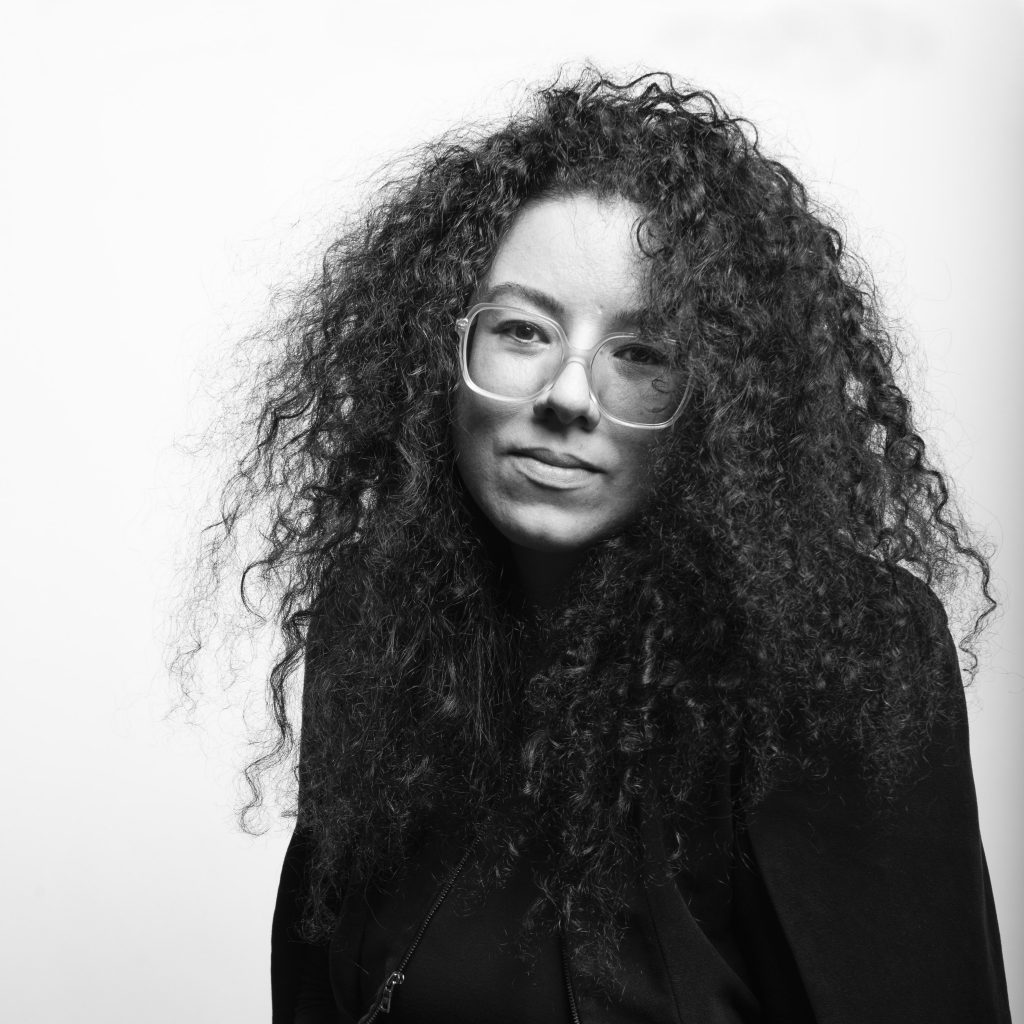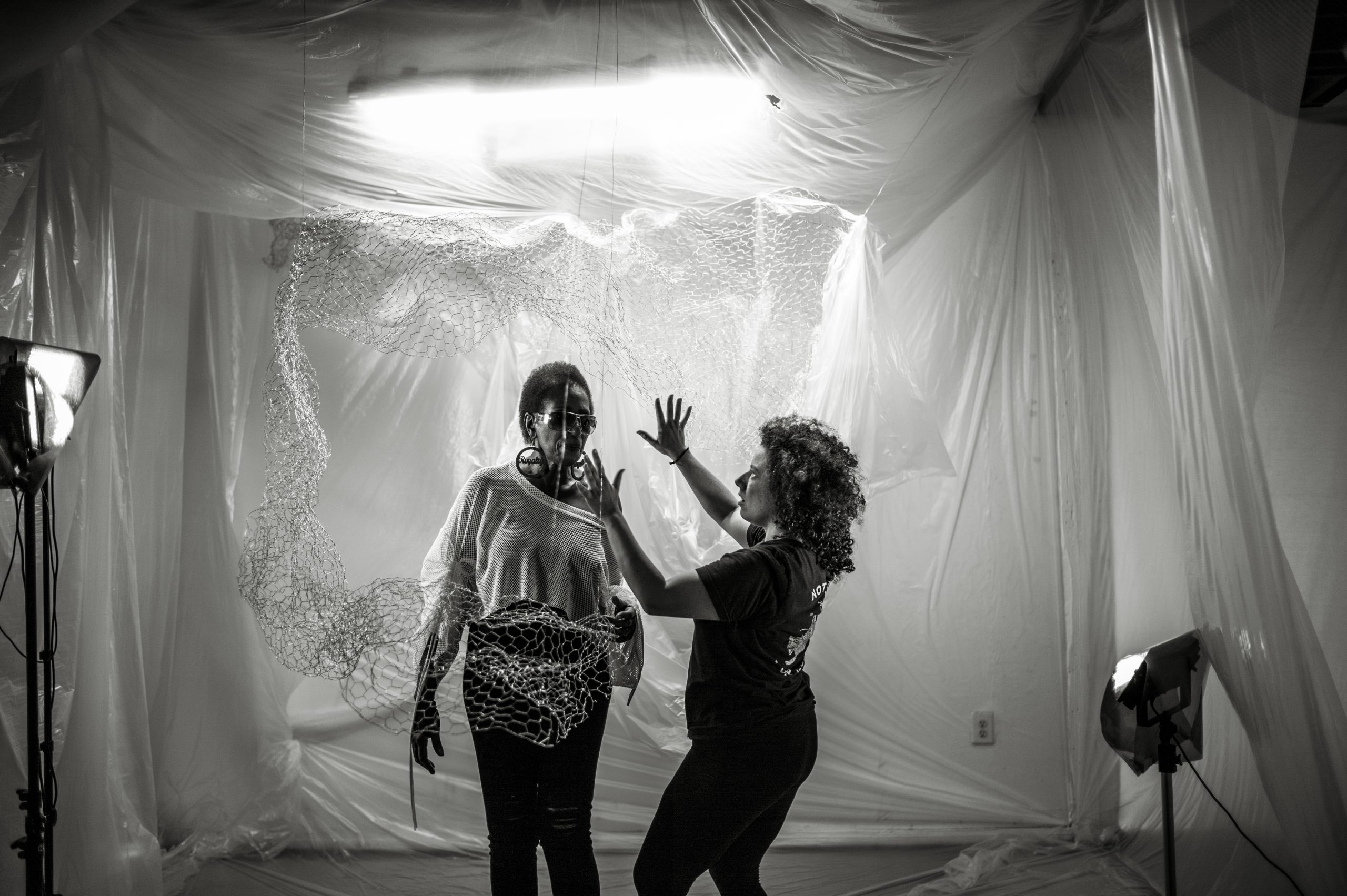Farida is straightforward and transparent, with no hidden agenda. She is open to the wildest of ideas an artist may suggest, jumping in with questions and clarifications to explore how an idea may be realized. She loves to collaborate with artists to help them find their voice, treating them with dignity and respect.
Kythe Heller, SOVO// Editor
Written by Erika Çilengir
Farida Amar, Owner and Creative Director of SOVO// Projects, is a creative maelstrom whose passion, commitment, ability to manage risk, and diligence have brought her to this point. Hers is a tale of an adventurous spirit with a laser focus on realizing dreams – both her own and those of the artists she champions. It is in this spirit that Farida nurtures SOVO//, a platform for independent artists looking for an encouraging, supportive, and creative environment in which to thrive. Over its relatively short life span (since 2018), SOVO// has garnered an impressive list of accomplishments.
With SOVO//, Farida’s vision is to create a philanthropic and self-sustaining foundation for the arts that provides living artists, including visual artists, performance artists, musicians, filmmakers, and writers, with the resources and support they need to create and collaborate – and learn to represent themselves.
As an artist herself, Farida has unique insight into what it takes to establish trust with the artists she represents. Farida also possesses a knowledge of how the business side of art works through her extensive marketing background, including how to put control of their art squarely in artists’ hands.
SOVO// started out with the intention of being a print publication supported by a community of artists. Instead, SOVO// has blossomed into a full-blown art collective that happens to produce an art publication once every three months. Even their quarterly releases have grown into full art exhibitions, showcasing the original contributions of up to 60 artists per issue. Twice a year, SOVO// also publishes half issues, which accompany a first-time solo exhibition for visual artists. But SOVO//’s innovations have not stopped there.
In 2019, SOVO// launched an analog film department, titled mm (pronounced “millimeter”). The team has completed numerous experimental short films and is now in pre-production on its first feature-length film, entitled “Gauze.” In September 2020, SOVO// launched Negative Efforts, an alternative processing and experimental printing photography workshop series for SOVO// photographers, led by Jack X. Proctor. The series will be captured in a coffee table book on alternative processing, currently in production.
To encourage SOVO//’s contributing writers, SOVO// hosts an annual Writers Residency program: a three-day, all-expenses-paid experience designed and moderated by SOVO// editors. Held in various venues surrounded by nature, the program is filled with intensive work sessions, seminars, and team-building exercises. The residencies offer writers creative space to critique and develop their work, as well as hone their unique artistic voice and perspective.
Also in 2019, SOVO// established an Art Board by offering small percentages of the company to only the most dedicated members of the platform. The Art Board gives artists a greater voice over their work and the decisions that could impact it. It also promotes a collaborative environment in which decision-making rests in the hands of many rather than one. In addition, SOVO// continues to participate in various shows, fairs, and other collaborations and takes on numerous side projects and events it deems worthy.
A sense of curiosity and wonder define Farida. She is driven by the belief that no matter how long you live, it is not long enough to explore everything to be explored.
Değer Özkan Çötelioğlu, Friend and Former Colleague at the Miami Ad School
Pivotal projects and experiences
Although the breadth and scope of Farida’s artistic output is impressive, a few seminal projects stand out as pivotal in her career thus far. Much of Farida’s work can be understood within the context of her self-described social theory, Strategic Destruction. Strategic Destruction is “a movement that deconstructs every limit ever agreed upon by the current institutionalized majority in order to instigate re-creation.” It is a theory that only those characterized by the following tenets can understand:
- You actively seek out inspiration
- You recognize that producing anything globally relevant is a collaborative effort
- You are open to believing things you cannot see
- You are not a traditionalist
After working on several international ad campaigns for Saatchi & Saatchi in Germany, Farida realized that selling ideas was not enough for her. She wanted to explore and understand ideas and how they evolve and impact people. This realization, while freeing, was also unnerving since all of her preparation thus far had been for a career in advertising, only to discover that that is not where her passion lay. Eventually, Farida left Saatchi & Saatchi, and moved to Istanbul, Turkey, where she began to reconnect with real people and consider her next step, to transition away from the marketing/advertising world and open SPACE, her first art collective and gallery space in Boston.
Neurosapien (under the auspices of SPACE and in collaboration with architect and community organizer Gabriel Bello Diaz) predates Farida’s written articulation of Strategic Destruction, but clearly embodies the concepts Farida later introduces in that social theory. The driving objective behind Neurosapien was to create a series of experimental installations that opened to the public only 24 hours after their creation. Alternative art spaces in El Hierro (one of the Canary Islands), Boston, Philadelphia, and Los Angeles hosted the installations, constructed dream worlds that brought together musicians, fine artists, audio engineers, photographers, and videographers from diverse backgrounds to collaborate for the first time. No rules, limitations, or expectations were placed on the teams; however, the teams were required to remain in their designated location for eight hours straight. All the work for each installation had to be completed within a very compressed period of time. Exhaustion was the norm at the end of it all, but so was elation.
Just months after Farida completed Strategic Destruction, she explored public and private self-expression through three installations she called The Public Anonymous, in collaboration with audio-visual design engineer Sarah Bearse. One of only a few of Farida’s projects that have been a direct reaction to political realities, The Public Anonymous set out to prove (or disprove) the hypotheses that people express themselves more freely if they can remain anonymous, contribute more openly when the destination of their input is known, and express themselves within the public sphere, whether it is virtual or concrete. The project arose in response to the Occupy Wall Street protests and encampments across the nation in 2011.
Finally, a year after publishing Strategic Destruction, Farida was invited to participate in Schmiede in Hallein, Austria, described by its creators as a “cooperative prototyping environment, focused on the arts, hacking and entrepreneurship.” Although Farida was just one of a group of artists invited to Schmiede in 2012, she managed to harness the collective imagination of her fellow artists to create The Opening of the Universe. Using that year’s theme, Zero, as her springboard, Farida chose to base her installation on morse code, the only language that can be directly translated into both light and sound, making it a starting point for multimedia communication. The name for the installation came from the work of a 7th Century Indian mathematician, Brahmagupta, who outlined seven major properties of zero. Over a couple of weeks, Farida and her fellow artists translated Brahmagupta’s seven properties of zero into morse code. Musicians then reinterpreted the code as soundscapes. The musical tracks they created were set up as mini-installations that included four films, two light installations, and one invented object.
Early childhood
Farida was born and raised in the Mojave Desert in California, the product of an eclectic family with roots in the Aztec Empire in Mexico and Germany on her mother’s side and in the Cherokee Nation and the Creole culture on her father’s side.
Although Farida lived with her parents until the age of 12, she was especially close to her maternal grandfather, a hypnotherapist with a magical garage, in which he invented many amazing things. He encouraged Farida to be imaginative and dream big. Her grandfather hypnotized Farida regularly as a child and introduced her to lucid dreaming, which has served Farida well over the years by allowing her to harness her dreams and imagine big ideas. Finally, he instilled in Farida a respect for wild animals and showed her how to care for them. Later Farida received a wildlife rehabilitation license, with large wild cat and avian specializations.
Farida was also greatly influenced by her Uncle Alfred, a NASA mathematician, who instilled in her the importance of contemplation and thought and his understanding of the difference between the two, namely that “contemplation” was “thinking about thinking.” Her uncle also taught Farida how to play the piano and insisted that Farida’s parents send her abroad to become “a citizen of the world.” When he died, he left behind his 4×5 large-format camera, which later played an important role in pushing her into film photography.
Education
Farida left home at the age of 12 to attend private prep schools in Redlands and later Riverside, California. She concurrently took night classes at UC Riverside that allowed her to begin chipping away at her college requirements.
At the age of 15, Farida moved to Spain as part of a high school exchange program. There, she studied International Communications and Spanish at the Universidad de Salamanca. The following year, Farida travelled to Italy, where she studied both Italian and Photography at the University of Richmond in Rome. While in Rome, she also served as an apprentice to documentary photographer Gianni Giansanti. These experiences cemented Farida’s appreciation for the underlying commonalities among all people, as well as the unique customs and practices within each culture.
Farida received her Bachelor of Science degree in Marketing Communications from Emerson College in Boston, with a specialization in Advertising at the age of 18. While at Emerson, Farida helped run the college’s student minority organizations under Smitty Smith, now the Founding Executive Director of the National Center for Race Amity. She also initiated a diversity training program, called “Campus Conversations on Race,” that focused on addressing systemic racism.
In addition to her academic pursuits, Farida completed an internship in Art Direction at Modernista!, where she was mentored by Gary Kopke.
Farida then moved on to Florida International University in Miami, where she earned her Master of Science degree in Mass Communication Theory at the age of 21. Her thesis focused on “Vocabulary for a Universal Visual Language.” Simultaneously, Farida completed a Professional Portfolio in Art Direction at the Miami Ad School. During this time, she also completed a curatorial internship at The Wolfsonian museum.
Farida’s attitude is always “we will get through this!” She exudes confidence and is quick to reassure her team that despite any obstacles they encounter, they will prevail.
Andru Perez, SOVO// ARTIST
Political appointments
In 2014, Farida was elected to the City Council in Downtown Los Angeles for a two-year term, serving on the Arts and Culture board, whose mission was to allocate funding for local artists and initiatives offering them support and resources.
Aviation
In learning to fly, Farida has absorbed important lessons in leadership, confidence, responsibility, flexibility, risk, and not quitting when you are afraid. Her four-year journey in flight thus far has led to Farida receiving her Commercial Helicopter Pilot License and now to working on her Commercial License for Fixed Wing. Toward that end, Farida recently purchased her own plane, a Mooney M20F that she has named Loreto.
Farida is affiliated with the Los Angeles 99s and the Whirly Girls. She has trained with the first FAA-certified aerobatic helicopter pilot Chuck Aaron, Sikorsky test pilot Kevin Bredenbeck, and Robinson helicopter test pilots Christian Naumann, Simon Jones, and Mick Lane.
Additional resources
For a video introduction to SOVO// and a succinct description of its mission and staff, check out: https://sovoprojects.com/about. For more details about Farida’s past projects, see https://www.faridaamar.com.

